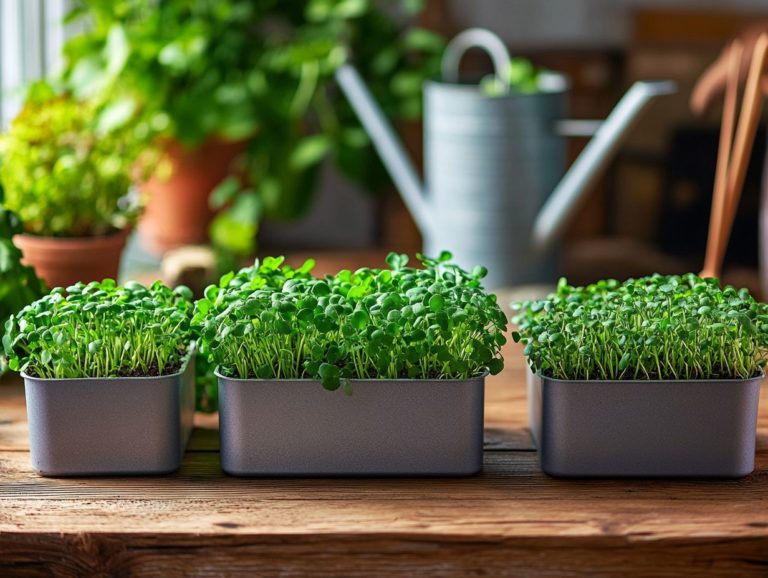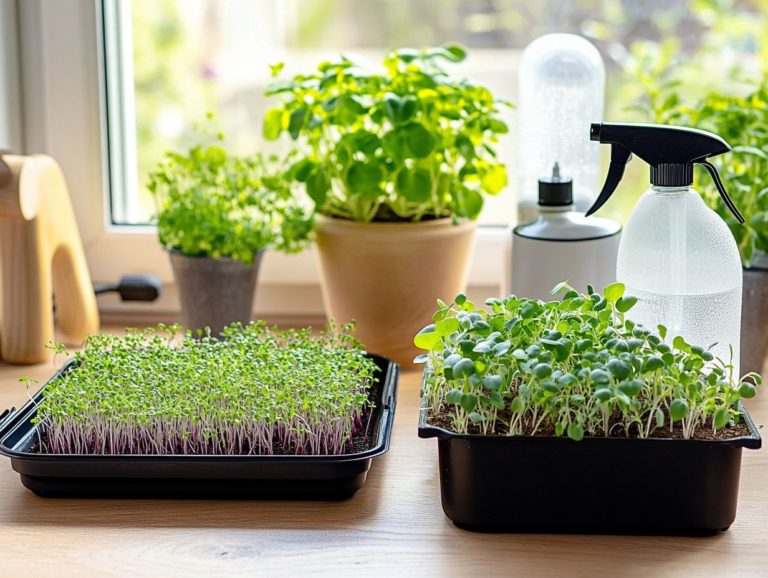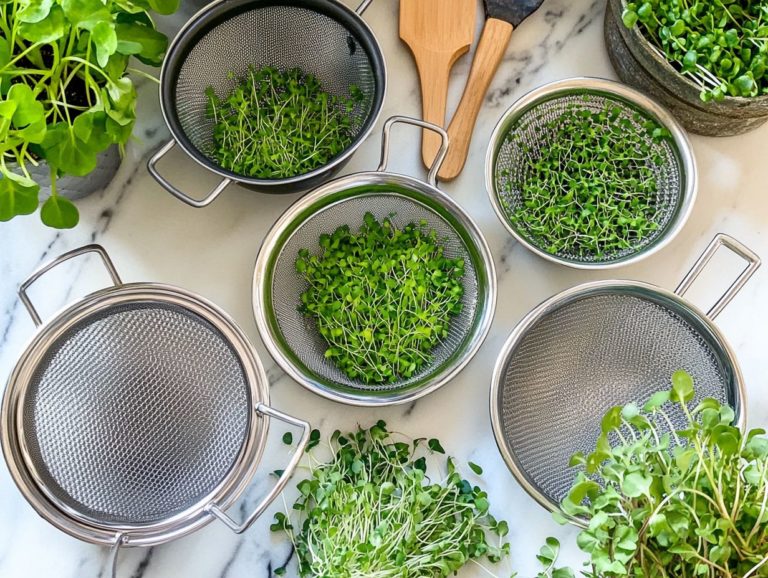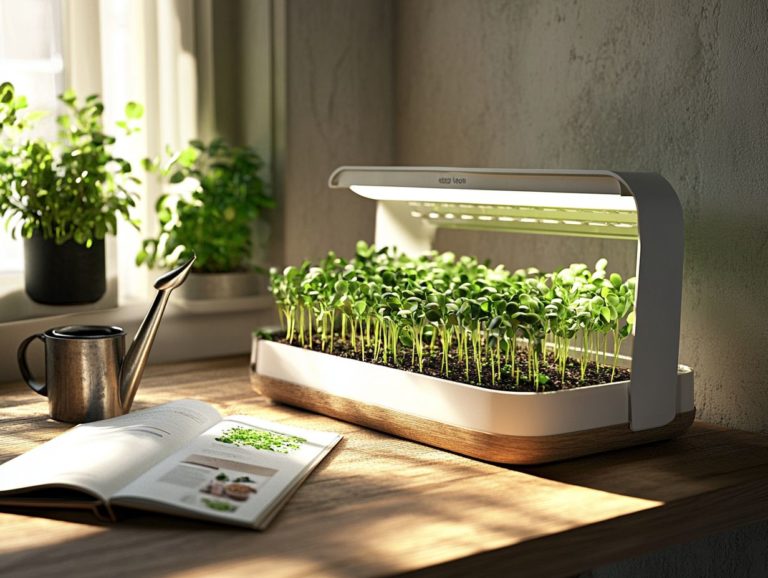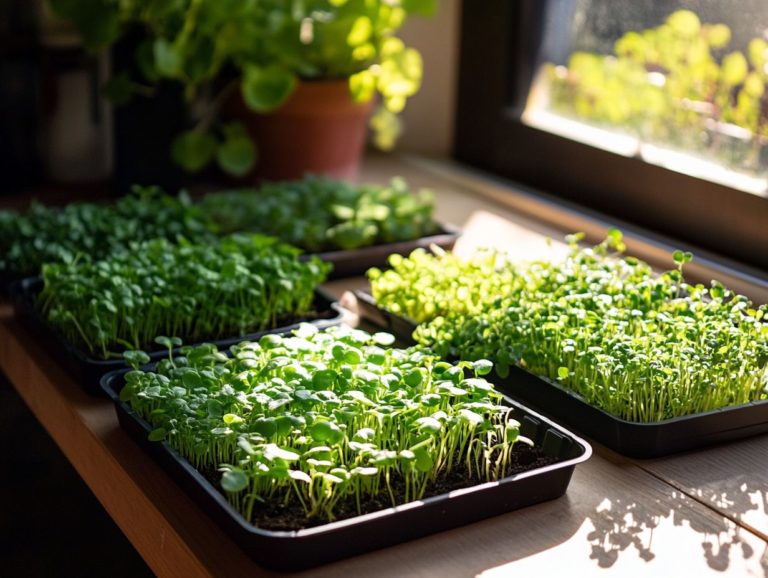Choosing the Right Humidity Tray for Microgreens
If you’re diving into the world of microgreens, understanding the significance of humidity trays can transform your gardening journey. These specialized trays are a game-changer for keeping your plants happy and hydrated!
You ll discover what humidity trays are, the numerous benefits they offer for microgreens, and the different types available to you.
Along the way, you’ll uncover practical tips for selecting the right tray, using it effectively, and keeping it clean to ensure your microgreens flourish. Prepare to elevate your indoor gardening experience like never before!
Contents
- Key Takeaways about Humidity Trays for Microgreens:
- What are Humidity Trays?
- Why Humidity Trays Matter
- Types of Humidity Trays
- Factors to Consider When Choosing a Humidity Tray
- How to Use a Humidity Tray for Microgreens
- Maintenance and Cleaning of Humidity Trays
- Frequently Asked Questions
- What is the purpose of a humidity tray for microgreens?
- How do I choose the right humidity tray for my microgreens?
- What material is best for a humidity tray for microgreens?
- Can I reuse a humidity tray for multiple batches of microgreens?
- Do I need a lid for my tray for humidity?
- How often should I water my microgreens in a tray for humidity?
Key Takeaways about Humidity Trays for Microgreens:
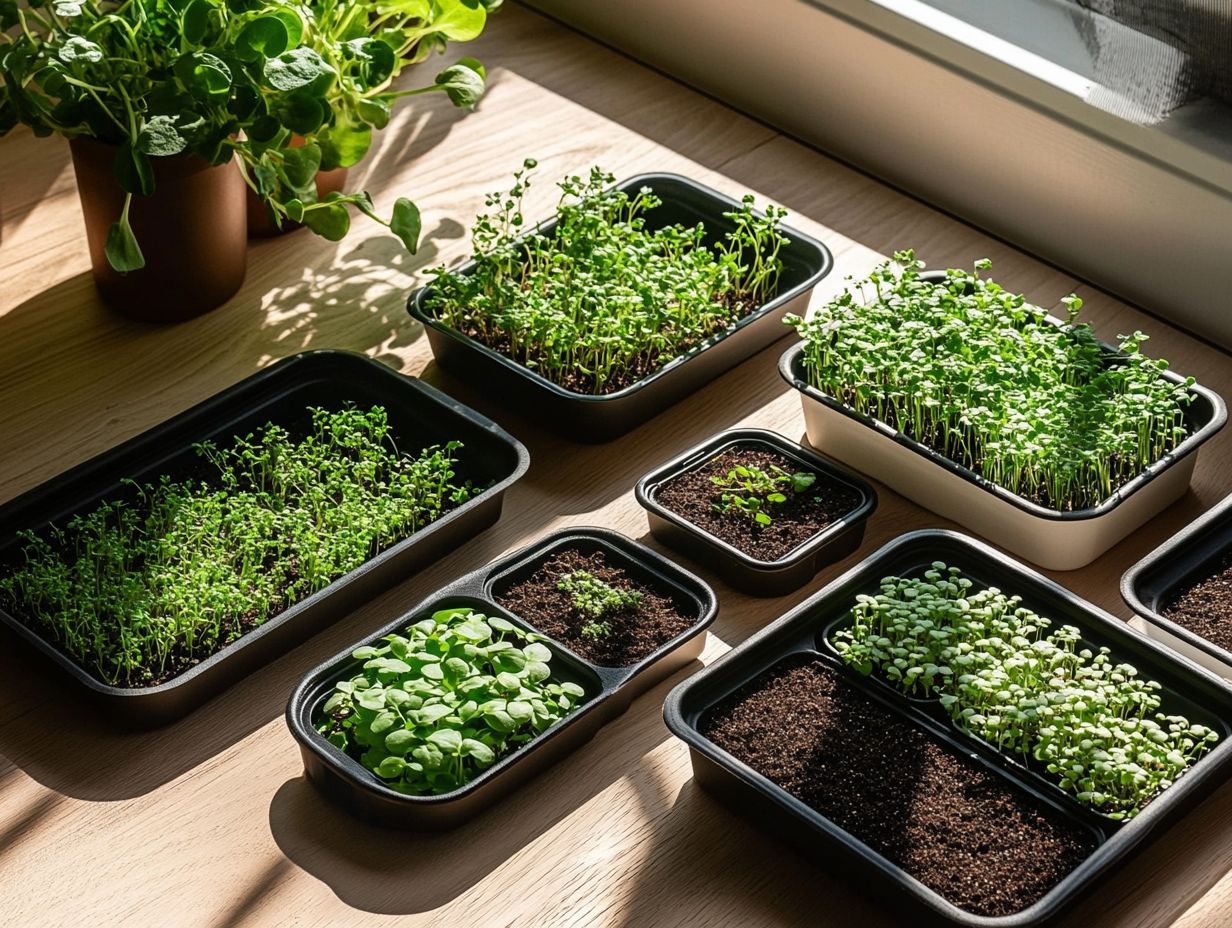
- Using a humidity tray can greatly benefit the growth and health of your microgreens, leading to higher yields and better quality produce.
- When choosing a humidity tray, consider factors such as the type of microgreen and growing conditions to ensure optimal results.
- Regular maintenance and cleaning of humidity trays are crucial for their effectiveness, so keeping them clean and properly stored is important for successful microgreen growth.
What are Humidity Trays?
Humidity trays are specialized containers designed to create the right amount of moisture for growing microgreens, ensuring their healthy development. These trays typically come equipped with drainage holes, allowing you to manage water levels effectively and prevent over-saturation, which can hinder seed germination.
By incorporating humidity trays into your growing routine, you provide an ideal setting for various microgreens, such as peas, sunflowers, and wheatgrass.
When you choose products from reputable brands like Bootstrap Farmer, including the 5X5 Grow Tray and the 1020 Deep Mesh, you elevate your cultivation process, making it more efficient and yielding superior results.
Definition and Purpose
The primary purpose of humidity trays is to provide you with a stable environment for your microgreens during their initial growth stages, ensuring they receive the moisture and nutrients they need.
These trays are expertly designed to create a microclimate an area with a controlled environment that helps plants thrive retaining moisture essential for seed germination and the delicate early development of seedlings. By trapping humidity, they prevent the soil from drying out too quickly, allowing your seeds to absorb water and swell effectively. This consistent moisture significantly reduces the risk of transplant shock later on, resulting in healthier plants.
Humidity trays cater to various microgreen species by creating tailored environments that suit their unique needs, ultimately enhancing growth rates and yields. To further optimize your microgreen cultivation, consider learning how to choose the right soil for microgreen growth, which will simplify the cultivation process for you.
Why Humidity Trays Matter
Incorporating humidity trays into your microgreen cultivation can elevate your gardening experience, providing numerous benefits that enhance both plant growth and health. These trays are essential for maintaining consistent moisture levels, a key factor for successful germination and thriving growth, especially for those delicate microgreen varieties.
Humidity trays enable bottom watering, reducing the risk of over-watering and encouraging deeper root development. Reusable trays enhance sustainability while ensuring optimal seed density and uniform growth across your soil blocks. This makes them a critical asset for growers of all levels, whether you re just starting out or have honed your skills over time.
Improved Growth and Health of Microgreens
Humidity trays are essential for enhancing the growth and health of your microgreens, as they maintain the ideal moisture and nutrient levels necessary for thriving plants.
These trays create a microclimate that sustains the perfect amount of humidity, crucial for keeping the soil adequately moist. By ensuring that the soil remains hydrated, you enable your microgreens to flourish without the fear of drying out. For optimal growth, consider using the best containers for microgreen cultivation. A stable humid environment can significantly lower the risk of common diseases, such as damping-off, a common issue where seedlings rot due to lack of moisture often seen in overly dry conditions.
This protective barrier promotes better root development, allowing your plants to grow robustly and absorb nutrients more effectively, ultimately leading to a healthier crop overall.
Types of Humidity Trays
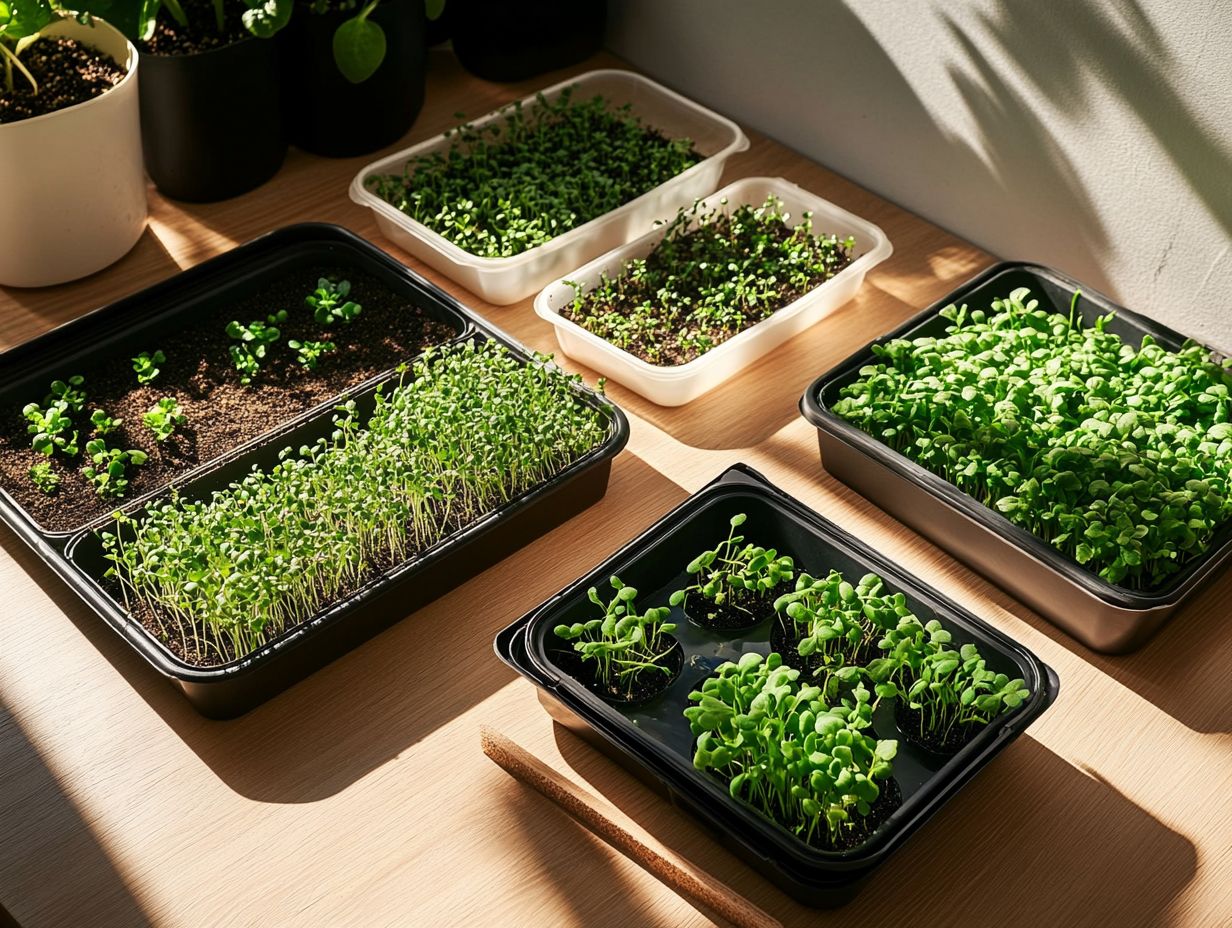
You ll discover exciting types of humidity trays available, each crafted from distinct materials and features to meet various needs in microgreen propagation. Whether you’re after heavy-duty trays for repeated use or specialized options like the 1010 Shallow Microgreen Tray and the 1020 Deep Mesh, there s plenty to choose from based on your specific requirements.
The material, design, and size of these trays can significantly affect drainage and how well they hold water. Understanding these differences is essential when selecting the perfect option for your growing setup.
Comparison of Materials and Designs
When comparing materials used in humidity trays, you’ll discover exciting differences that can greatly impact your microgreen growth and maintenance.
Explore options such as plastic, terracotta, and metal to gain insights into how each material’s unique properties either foster or hinder the development of your microgreens. For example, plastic trays are lightweight and moisture-resistant, but they may struggle with drainage, leading to overwatering dilemmas.
In contrast, terracotta provides excellent drainage thanks to its porous nature, but it requires more frequent cleaning and can be susceptible to cracking under certain conditions. Meanwhile, metal trays are durable and easy to clean, but their effectiveness can vary based on design and coating, ultimately influencing moisture retention and evaporation rates.
Factors to Consider When Choosing a Humidity Tray
When choosing the perfect humidity tray for your microgreen cultivation, it s crucial to consider several key factors to achieve optimal results:
- Drainage holes: Ensure effective water management.
- Soil media compatibility: Look for trays that work well with coconut coir and peat moss.
By understanding these elements, you can make informed decisions that will enhance the growth and vitality of your microgreens. Don’t miss out on the chance for the best growth!
Microgreen Variety and Growing Conditions
Understanding the specific microgreen variety and its growing conditions is crucial when selecting the right humidity tray for optimal growth.
Different microgreens, like wheatgrass and fodder, have unique environmental needs that significantly impact your choice of humidity tray. For instance, wheatgrass thrives in slightly drier conditions, often requiring trays that allow better air circulation to prevent mold.
On the other hand, fodder prefers higher humidity levels, which help retain moisture and promote quicker germination. This variation means your choice of tray must align with the specific moisture retention and drainage ability required by each microgreen, ultimately influencing their health and yield.
By thoughtfully considering these conditions, you can create an ideal setup for flourishing microgreens.
How to Use a Humidity Tray for Microgreens
Utilizing a humidity tray for your microgreens can significantly elevate your growing experience. Begin by selecting an appropriate humidity tray and preparing your soil blocks or propagation trays with ideal soil media, such as coconut coir or peat moss.
Once your soil is set, evenly distribute your seeds across the tray, taking care with seed density. After planting, use the bottom watering method to maintain optimal hydration for your microgreens, allowing any excess water to drain away.
By following these steps, you ll be well on your way to successfully cultivating vibrant microgreens.
Step-by-Step Instructions
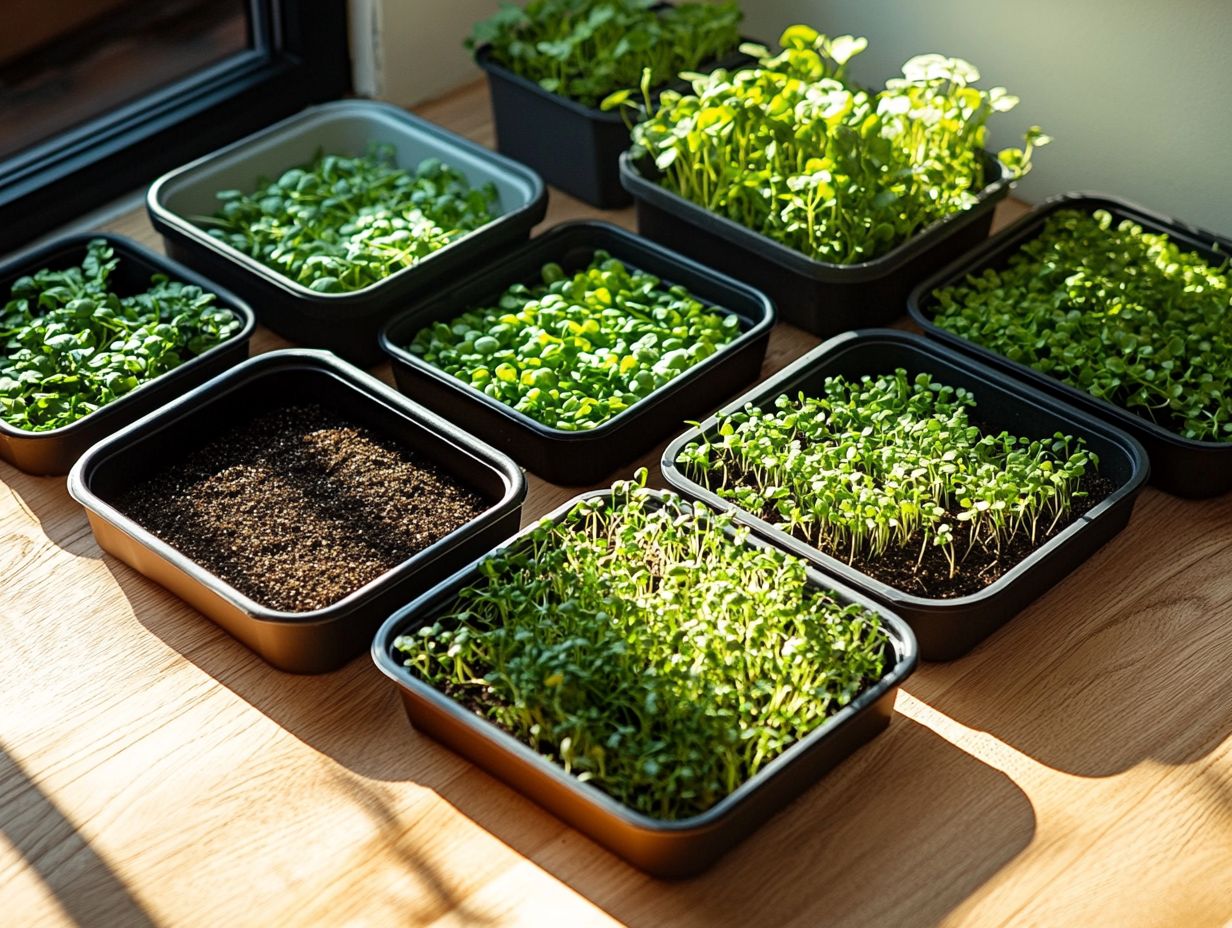
To effectively use a humidity tray for growing your microgreens, follow these step-by-step instructions to ensure your success.
-
Prepare your humidity tray. Ensure it s clean and free from old residue that could attract pests or diseases.
Select a suitable growing medium a soil mix that drains well but holds enough moisture. Once you ve filled the tray with your chosen mix, gently level it out, and moisten the substrate evenly.
-
Now it s time to sow your microgreens seeds. Sprinkle them evenly across the surface, ensuring adequate spacing for optimal growth. After planting, cover the seeds lightly with additional soil or vermiculite and mist gently.
-
Place a clear lid or plastic wrap over the tray to maintain humidity. Check daily to ensure moisture levels remain stable. Water carefully from the bottom using the tray s reservoir to keep the soil damp without oversaturating it.
By following these practices, you ll be well on your way to cultivating vibrant, thriving microgreens.
Maintenance and Cleaning of Humidity Trays
Keeping your humidity trays clean and maintained is key to growing vibrant microgreens! Regularly inspect your reusable trays, made from food-safe plastic, to confirm they are free from mold, algae, or leftover soil.
Use mild, eco-friendly cleaning agents to gently scrub the trays after each use, eliminating any contaminants. These maintenance practices not only keep your humidity trays sparkling clean, but they also significantly boost the overall success of your microgreen growing setup.
Tips for Keeping Trays Clean and Effective
To ensure your humidity trays remain effective for growing microgreens, regular cleaning and maintenance are essential. This routine promotes healthier plant growth and helps prevent harmful contaminants from building up.
By routinely inspecting your trays, you’ll catch signs of mold or algae early, which could otherwise jeopardize your entire growing process.
For cleaning, use mild soap and a soft brush. This approach helps eliminate residues without damaging the trays. Incorporating a sanitation schedule into your gardening practices will enhance the longevity of your trays, ensuring they function efficiently.
Ultimately, a clean and well-maintained humidity tray creates a thriving environment for optimal microgreen development.
Frequently Asked Questions
What is the purpose of a humidity tray for microgreens?
A humidity tray helps keep the air moist for growing microgreens. This is important because microgreens require a specific level of humidity for optimal growth.
How do I choose the right humidity tray for my microgreens?
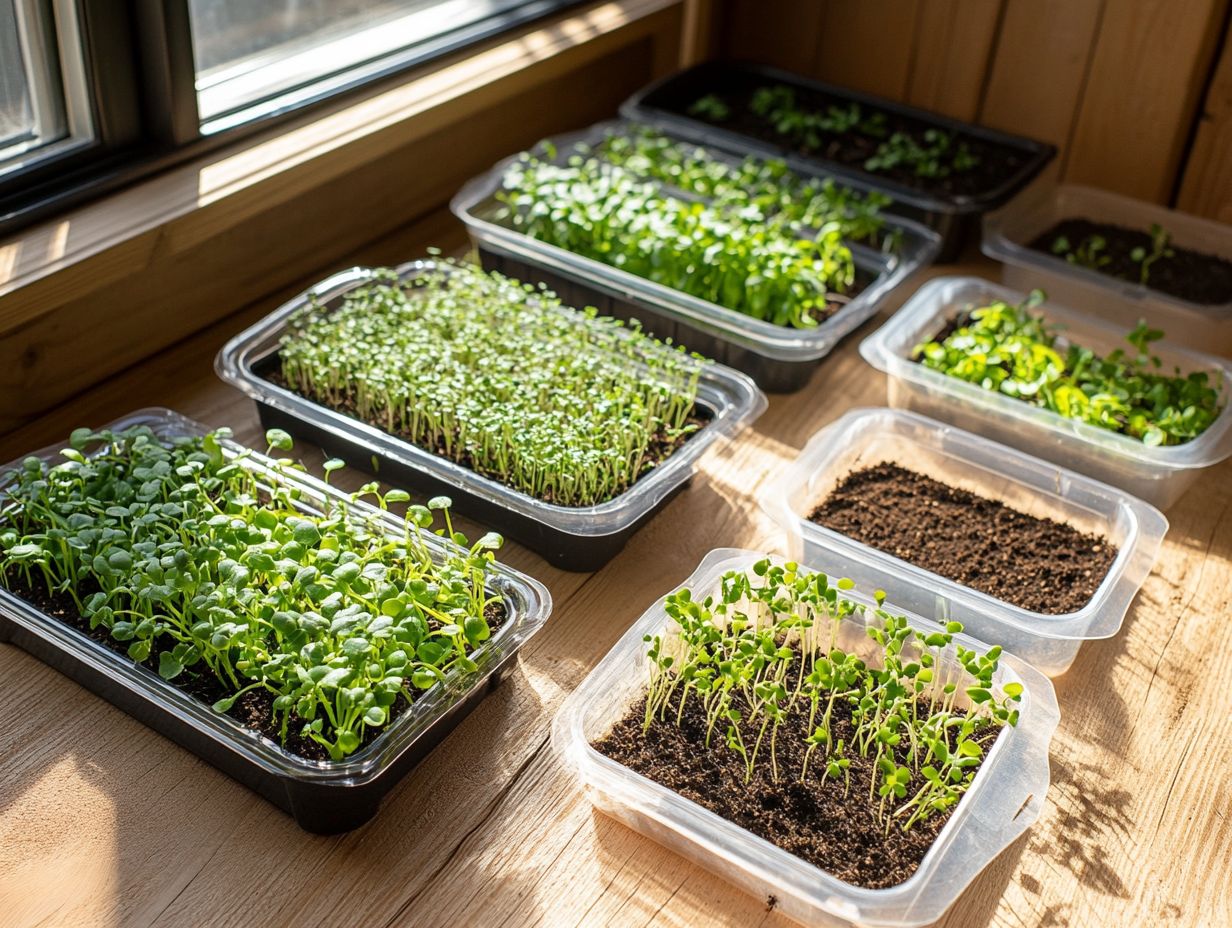
First, determine the size and type of microgreens you will be growing. This will help you choose the appropriate tray size and material. Consider the humidity levels in your growing area and select a tray that can maintain the desired moisture levels for your microgreens.
What material is best for a humidity tray for microgreens?
The most commonly used material for humidity trays is plastic, as it is lightweight, affordable, and easy to clean. However, ceramic, metal, and glass trays can also be used, depending on personal preference and the type of microgreens being grown.
Can I reuse a humidity tray for multiple batches of microgreens?
Yes, you can reuse a humidity tray for multiple batches of microgreens as long as it is properly cleaned and sanitized between uses. This will help prevent the growth of mold or bacteria that could harm your microgreens.
Do I need a lid for my tray for humidity?
You don t need a lid for your tray for humidity. However, using one can create a controlled environment for your microgreens.
If you live in a dry area or grow moisture-sensitive varieties, a lid can help retain moisture and boost humidity.
How often should I water my microgreens in a tray for humidity?
Watering frequency varies with the type of microgreens and humidity levels in your space. Check the soil moisture regularly to ensure your greens get the right amount of water.

